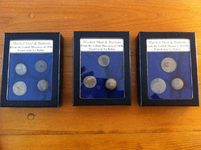Navigation
Install the app
How to install the app on iOS
Follow along with the video below to see how to install our site as a web app on your home screen.
Note: This feature may not be available in some browsers.
More options
You are using an out of date browser. It may not display this or other websites correctly.
You should upgrade or use an alternative browser.
You should upgrade or use an alternative browser.
musket ball ?
- Thread starter scs
- Start date
gunsil
Silver Member
- Dec 27, 2012
- 3,863
- 6,205
- Detector(s) used
- safari, ATPro, infinium, old Garrett BFO, Excal, Nox 800
- Primary Interest:
- All Treasure Hunting
The object in question is an iron pyrite nodule. Google them and you will see others, I have found many myself. I personally doubt (no offense intended) That Tejass' bronze ball is a musket projectile, and it is without a doubt that the indians did not have the ability to cast bronze, or use it for projectiles. I suggest any who think this true about indians casting bronze projectiles try to do it. Lead and it's common alloys melt at a very low temperature, and bronze, copper, and brass melt at MUCH higher temperatures, and these are not suitable to casting into small round molds made of brass or iron. Lead melts around 600 degrees F and bronze and brass in the 1700-1850 degree F range. The southwestern Native Americans did not start casting silver jewelry until they were taught how to do it in the late 1800s-early 1900s. The Native Americans are considered a stone age culture since they had no real metal usage except for the rare copper items that were not cast, but pounded from existing native copper. They did not have the capability to cast copper.
Last edited:
Upvote
0
l.cutler
Silver Member
- Dec 2, 2006
- 2,722
- 2,121
- Detector(s) used
- Tejon, Cibola, T2
- Primary Interest:
- All Treasure Hunting
As I said, a musket ball would be larger, certainly there are rifle and pistol balls of a similar size and smaller, but the question was whether it was a musket ball. I know of no muskets smaller than .69 caliber. You are correct though that there can be off metal round balls although uncommon, I guess whatever material was at hand.The following is not in regards to the OPs find... If he can get his hands on a caliper and/or grain scale I'd be more than happy to help ID what he has. I.cutler - Please DO NOT use "material" to rule something out of being identified as a round ball. That logic can only be applied loosely to Minies and other "conical shot". Depending on the times, country, and individual, round balls were made of VARIOUS conglomerates. Instead, use measurement, weight, and "vicinity likelihood" as a basis. "Larger"? - no, not necessarily. There were plenty of smaller caliber pistol balls, and the US used buck-and-ball loads almost exclusively in certain long arm models for more than two decades in various regions... Case and point, from my personal collection - Mexican BRONZE musket shot found In the vicinity of the La Bahia massacre. The French, from which Michigan (OPs location) derives it's name from.... supplied a lot of the local inhabitants (Indians) with firearms during the Seven Years War. Indians would commonly use trade ingots and scrap (lead/iron/bronze) to manufacture shot for their muskets. I'm not saying the OP did/didn't find a round ball. I'm simply trying to show that there is more to take into account. You don't want to just chuck that into the trashcan assuming it's a rusty ball bearing!
Last edited:
Upvote
0
gunsil
Silver Member
- Dec 27, 2012
- 3,863
- 6,205
- Detector(s) used
- safari, ATPro, infinium, old Garrett BFO, Excal, Nox 800
- Primary Interest:
- All Treasure Hunting
The outside of SCS' nodule already displays the fool's gold. Pyrite nodules when cracked open often look more silvery and will not show "flecks", but more of a crystalline structure. I won't attempt to refute Tejass's theory about bronze musket balls any more, evidently he knows what he has, but I'm sure if cannonballguy saw this he would have something interesting to say. Obviously some folks just don't realize the difference in the difficulty of casting different metals and will believe what they wish regardless of facts.
Upvote
0
Top Member Reactions
-
 3512
3512 -
 2069
2069 -
 1908
1908 -
 1306
1306 -
 1064
1064 -
 1052
1052 -
 949
949 -
 888
888 -
 868
868 -
 774
774 -
 762
762 -
 623
623 -
 560
560 -
 558
558 -
 477
477 -
 466
466 -
 415
415 -
 409
409 -
E
405
-
 379
379
Users who are viewing this thread
Total: 2 (members: 0, guests: 2)








